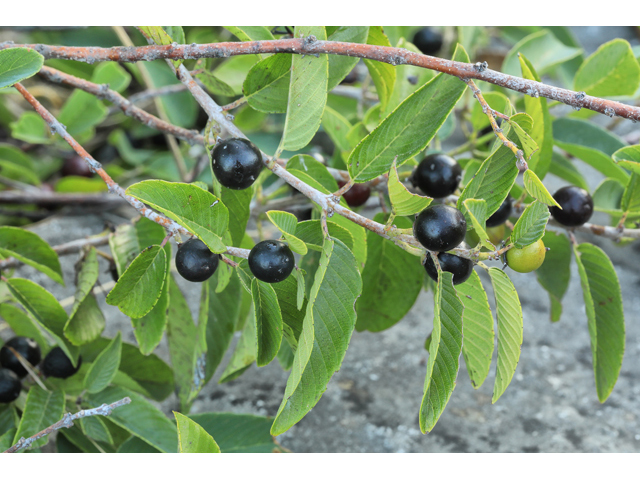
Native to the prairies, plains, meadows, pastures, and savannas of southern and western Texas as well as much of Mexico, this evergreen shrub or small tree is a member of the buckthorn family, Rhamnaceae, that also includes California lilac (Ceanothus spp.), and jujube tree. The plant grows 1-20′ tall (more commonly 6′), is much branched, and has a spineless stem. The elliptical to oval, dark green leaves are 1-3″ long and have prominent veins and slightly recurving margins. From summer to fall, clusters of small greenish flowers with 5 petals appear in the leaf axils and give way to fleshy, berry-like fruits that are 1/2″ across, one-seeded, and dark red, brown, or black . The seeds, as well as the leaves, are toxic to humans and livestock. In spite of their toxicity, the plant is valued for it heat and drought tolerance and used as an ornamental in the garden especially in hot, dry areas. The genus name, Karwinskia, honors Bavarian naturalist Baron Wilhelm Friedrich Karwinsky von Karwin, who collected plants in Mexico from 1826-1831, and 1840. The specific epithet, humboldtiana, honors Alexander von Humboldt, a German polymath, geographer, naturalist, explorer and proponent of Romantic philosophy and science.
Type: Evergreen shrub or small tree
Outstanding Feature: Foliage, heat and drought tolerance
Form: Rounded
Growth Rate: Moderate
Bloom: Small greenish axillary flowers in summer and fall
Size: 1-20′ H x 1-10′ W
Light: Full sun; tolerates some shade
Soil: Sandy to loam and clay, dry, well-drained, alkaline
Hardiness: Zones 8-12 (?)
Care: Low maintenance
Pests and Diseases: None of significance
Propagation: Seed
Outstanding Selections: None available
Photo Credit: Alan Cressler, wildflower.org